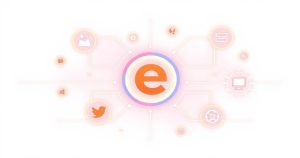In the dynamic world of online selling, Etsy integrations serve as powerful tools for sellers aiming to streamline operations, enhance customer experience, and scale their businesses effectively. These specialized applications connect directly with an Etsy shop, automating tedious manual tasks and transforming complex workflows into efficient, manageable processes. By leveraging the right integrations, sellers can free up valuable time previously spent on routine administrative work, allowing them to focus more on creative endeavors, product development, and strategic growth. Embracing these technological enhancements is crucial for building a robust and responsive online presence, ultimately leading to greater success and sustainability in the competitive e-commerce landscape.
Defining Etsy Shop Integrations
Etsy shop integrations are third-party software solutions designed to seamlessly connect with an Etsy store through its Application Programming Interface (API). These tools extend the native functionalities of the Etsy platform, bridging gaps and adding advanced capabilities that are not inherently available. The primary purpose of these integrations is to automate various aspects of a seller’s operations, from order processing to marketing, ensuring data synchronization and an overall enhanced workflow. They act as essential connectors, allowing sellers to manage their business more efficiently and effectively across different platforms and services.
Key Categories of Etsy Integrations for Enhanced Operations
1. Streamlining Shipping and Order Fulfillment
Efficient shipping is paramount for any Etsy shop, and specialized integrations significantly simplify this critical process. These tools automate the creation of shipping labels, often offering discounted rates from various carriers, which can lead to considerable cost savings. Sellers can also benefit from features like batch processing for multiple orders, drastically reducing the time spent on manual data entry and minimizing the potential for human error in addressing and package details.
Furthermore, shipping integrations provide robust tracking capabilities and automated customer notifications. This ensures buyers are kept informed about their order’s journey, improving transparency and satisfaction. By integrating these services, sellers can offer a more professional and reliable fulfillment experience, which is crucial for building a strong reputation and fostering repeat business on the Etsy platform.
2. Empowering Print-on-Demand (POD) and Dropshipping
For sellers offering custom designs or operating on a dropshipping model, print-on-demand (POD) integrations are indispensable. These integrations establish a direct, automated connection between an Etsy listing and a chosen POD supplier. When a customer places an order on Etsy, the integration automatically transmits the order details, including the design and shipping information, directly to the POD provider for production and fulfillment.
This automation allows Etsy sellers to scale their product lines significantly without the need to manage physical inventory or handle shipping logistics themselves. It is particularly beneficial for artists and designers who wish to offer a wide range of custom products, such as apparel, mugs, or home decor, enabling them to focus solely on creative work and marketing, while the integration manages the complexities of production and delivery.
3. Simplifying Accounting and Financial Management
Managing the financial aspects of an Etsy shop can be time-consuming and prone to errors if done manually. Accounting integrations automate the syncing of all transaction data, including sales, Etsy fees, refunds, and shipping costs, directly into preferred accounting software. This ensures that financial records are always up-to-date and accurate, providing a clear overview of the shop’s profitability.
These integrations are invaluable for tax preparation, expense tracking, and generating comprehensive financial reports. By eliminating the need for manual data entry, sellers can significantly reduce the risk of human error and save countless hours, allowing them to make informed financial decisions and maintain compliance without the usual stress associated with bookkeeping tasks for their Etsy business.
4. Optimizing Inventory and Multi-Channel Management
For Etsy sellers managing a diverse product catalog or selling across multiple online platforms, inventory management integrations are crucial. These tools synchronize stock levels in real-time across Etsy and any other sales channels, effectively preventing overselling and ensuring accurate inventory counts. They streamline the process of updating product listings, whether it’s adjusting quantities or modifying product details.
The strategic advantage of centralizing inventory control is immense, especially for growing businesses. These integrations provide a unified dashboard to monitor stock, track sales performance across different platforms, and efficiently manage product variations. This comprehensive oversight empowers sellers to maintain optimal stock levels, avoid frustrating customer experiences due to unavailable items, and operate their multi-channel sales strategy with greater precision and control.
5. Boosting Customer Relationship Management and Marketing
Effective customer engagement is vital for fostering loyalty and driving repeat purchases on Etsy. Integrations focused on customer relationship management (CRM) and marketing automation help sellers nurture their customer base. These tools can automatically add new Etsy customers to email marketing lists, enabling the sending of newsletters, promotional offers, and personalized follow-up messages.
Additionally, some integrations facilitate targeted marketing campaigns, such as abandoned cart reminders or special discounts for loyal customers, significantly improving conversion rates. By tracking customer interactions and purchase history, sellers can personalize their communication, making customers feel valued and encouraging them to return. This strategic approach to marketing and customer service strengthens brand relationships and contributes to sustained business growth.
6. Enhancing Product Design and Mockup Creation
For many Etsy sellers, particularly those in the apparel, print, or custom goods niches, presenting products appealingly is key to attracting buyers. Integrations that connect with product design and mockup creation tools can dramatically enhance this process. These platforms allow sellers to create professional, high-quality visual representations of their products without needing advanced graphic design skills or photography setups.
These tools often feature libraries of customizable mockups, enabling sellers to display their designs on various items, such as t-shirts, mugs, or digital prints, in realistic settings. Some even offer direct integration with POD suppliers, streamlining the transfer of finalized designs. This efficiency in generating compelling product images ensures that listings are visually attractive, helping sellers effectively communicate their product’s appeal and increase conversion rates on Etsy.
Strategic Considerations for Adopting Etsy Integrations
The decision to adopt Etsy integrations should be a strategic one, carefully aligned with a seller’s specific business needs and growth objectives. It is essential to conduct thorough research, evaluating each integration’s features, ease of use, pricing structures, and compatibility with existing workflows. Sellers should identify their most pressing pain points—whether it’s managing inventory, streamlining shipping, or enhancing customer communication—and then seek solutions that directly address those challenges.
Starting with a few key integrations that offer the most immediate benefits can provide valuable insights before expanding further. Reading user reviews and understanding the level of customer support provided by the integration developer are also crucial steps. A thoughtful approach ensures that chosen tools genuinely enhance operational efficiency and contribute to the long-term success of the Etsy shop, rather than adding unnecessary complexity.
Conclusion: Unlocking Your Etsy Shop’s Full Potential
Etsy integrations offer a powerful pathway for sellers to transform their shops from manual operations to highly efficient, automated enterprises. By strategically selecting and implementing these tools, sellers can significantly streamline daily tasks, enhance the customer experience, and unlock new avenues for scalability and growth. From simplifying shipping and accounting to empowering print-on-demand and boosting marketing efforts, integrations provide the technological leverage needed to succeed.
Embracing these advancements is not just about efficiency; it is about empowering sellers to focus on their core passion and creativity. The continuous evolution of available integrations means that Etsy sellers have a wealth of options to optimize every facet of their business. A proactive and informed approach to integrating these powerful tools will undoubtedly lead to sustained success and a more rewarding selling journey on Etsy.




